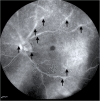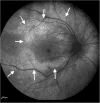Acute syphilitic posterior placoid chorioretinitis: when the great mimicker cannot pretend any more; new insight of an old acquaintance
- PMID: 35192047
- PMCID: PMC8864036
- DOI: 10.1186/s12348-022-00286-2
Acute syphilitic posterior placoid chorioretinitis: when the great mimicker cannot pretend any more; new insight of an old acquaintance
Abstract
Purpose: To review the multimodal imaging patterns of Acute Syphilitic Posterior Placoid Chorioretinitis (ASPPC).
Methods: A systematic review.
Results: Syphilis has started to attract the attention of researchers once again due to recent surges, with The World Health Organization (WHO) reporting around 12 million new cases per year. When left untreated, syphilis has a mortality rate of 8-58%, with a higher death rate in males. Eye manifestations occur both in secondary and tertiary stages of syphilis, although ocular involvement may occur at any stage of the disease. Syphilis has been always recognized as "the great mimicker" since it can have multiple clinical patterns of presentation. However, Acute Syphilitic Posterior Placoid Chorioretinitis (ASPPC) represents the typical pattern of the disease and can be easily distinguished. In addition, the advent of modern technologies and the progress made in multimodal imaging have provided more details on its identikit: the pattern of pre-retinal, retinal, retinochoroidal and optic nerve involvement can be identified before going through the laboratory work-up for a correct and appropriate investigation of the disease.
Conclusion: This review highlights the peculiar pattern of ASPPC, by reporting the diagnostic process made by all the imaging techniques used for a correct multimodal imaging assessment.
Keywords: Multifocal retinitis; Posterior uveitis; Pre-retinal precipitates; Retinochoroiditis; Syphilis.
© 2022. The Author(s).
Conflict of interest statement
P Neri and Pichi F declare that they have no conflict of interest.
Figures







Similar articles
-
Multimodal imaging patterns of posterior syphilitic uveitis: a review of the literature, laboratory evaluation and treatment.Int Ophthalmol. 2020 May;40(5):1319-1329. doi: 10.1007/s10792-020-01285-9. Epub 2020 Jan 11. Int Ophthalmol. 2020. PMID: 31927680
-
MULTIMODAL IMAGING ADDS NEW INSIGHTS INTO ACUTE SYPHILITIC POSTERIOR PLACOID CHORIORETINITIS.Retin Cases Brief Rep. 2018 Fall;12 Suppl 1:S3-S8. doi: 10.1097/ICB.0000000000000645. Retin Cases Brief Rep. 2018. PMID: 29023263
-
Spontaneous resolution of acute syphilitic posterior placoid chorioretinitis: reappraisal of the literature and pathogenetic insights.GMS Ophthalmol Cases. 2020 May 4;10:Doc26. doi: 10.3205/oc000153. eCollection 2020. GMS Ophthalmol Cases. 2020. PMID: 32676271 Free PMC article.
-
Acute syphilitic posterior placoid chorioretinitis: report of a case series and comprehensive review of the literature.Retina. 2012 Oct;32(9):1915-41. doi: 10.1097/IAE.0b013e31825f3851. Retina. 2012. PMID: 22863970 Review.
-
[Atypical acute syphilitic posterior placoid chorioretinitis].Ophthalmologe. 2017 Jun;114(6):563-566. doi: 10.1007/s00347-016-0327-4. Ophthalmologe. 2017. PMID: 27461014 German.
Cited by
-
A case of acute syphilitic posterior placoid chorioretinitis showing improved choroidal blood flow after treatment.Am J Ophthalmol Case Rep. 2023 Jul 3;32:101880. doi: 10.1016/j.ajoc.2023.101880. eCollection 2023 Dec. Am J Ophthalmol Case Rep. 2023. PMID: 37456147 Free PMC article.
-
Serpiginous Choroiditis After COVID-19 Infection.J Vitreoretin Dis. 2024 Nov 14:24741264241297936. doi: 10.1177/24741264241297936. Online ahead of print. J Vitreoretin Dis. 2024. PMID: 39554631 Free PMC article.
-
Atypical Acute Ischemic Choriocapillaritis: A Case Report.Clin Case Rep. 2024 Dec 16;12(12):e9646. doi: 10.1002/ccr3.9646. eCollection 2024 Dec. Clin Case Rep. 2024. PMID: 39691487 Free PMC article.
-
En Face Optical Coherence Tomography and Optical Coherence Tomography Angiography for the Diagnosis and Monitoring of Syphilitic Posterior Placoid Chorioretinopathy.J Vitreoretin Dis. 2025 Aug 3:24741264251358634. doi: 10.1177/24741264251358634. Online ahead of print. J Vitreoretin Dis. 2025. PMID: 40765985 Free PMC article.
-
Posterior placoid-like maculopathy and macular hole associated with vitamin A deficiency.Am J Ophthalmol Case Rep. 2022 Dec 7;29:101772. doi: 10.1016/j.ajoc.2022.101772. eCollection 2023 Mar. Am J Ophthalmol Case Rep. 2022. PMID: 36544748 Free PMC article.
References
-
- Centers for Disease Control and Prevention . Sexually transmitted disease surveillance 2015. Atlanta: U.S. Department of Health and Human Services; 2016. p. 2016.
Publication types
LinkOut - more resources
Full Text Sources

